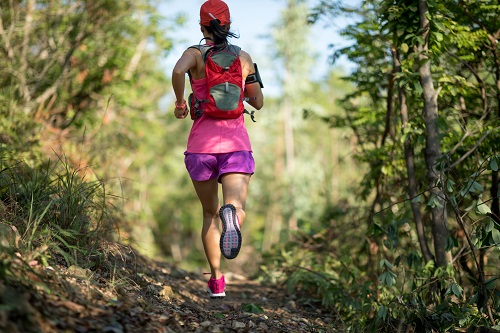
Road race organizers are expecting to see a return to pre-2020 numbers this year according to one survey, but the bigger news is in the trail running sector. Trail running has grown by an astonishing 231 percent over the past 10 years but even more importantly, the payouts for winners are increasing, the product of a growing participant base.
The influx of prize money was the subject of an article in Trail Runner Magazine. The article noted that while trail running traditionally has not been a moneyed sport, it has quietly been making inroads into that space. Additionally, more of the elite runners are getting lucrative contracts from their sponsors, with bonus money for top finishes at races.
“(The prize money) is way better than it’s ever been, both for the athletes earning it and the number of sponsors who are contributing to it,” Nancy Hobbs, executive director of the American Trail Running Association (and also the chairperson of the USATF Mountain Ultra Trail Council that oversees national championship races and the U.S. Mountain Running Team) told reporters at Trail Runner.
Something else interesting? Trail running just formed its first union: The Pro Trail Runners Association.
Ultramarathon trail races are a growing market. Although still a niche sport, they have a rabid fanbase who livestream races. And gradually, those races are adding prize funds. The Ultra-Trail du Mont-Blanc (UTMB), a single-stage mountain ultramarathon, first held in 2003, follows the route of the Tour du Mont Blanc and is a top destination of ultra-runners.
Still, it only began offering prize money in the last five years; according to the Trail Runner article, the race’s founders believed that monetary prizes would bring incentive for some athletes to consider doping or that agents would take too big of a cut. (In the interim, it has partnered with IRONMAN and created the UTMB Series, with lucrative payouts for winners).
Fred Abramowitz, one of the co-organizers of Run Rabbit Run, wrote a document, entitled “A Blueprint for Sponsors of Ultrarunning.” In that, he stated that casual runners enjoyed following the bigger ultras and would livestream events. He saw it as an opportunity to help forge connections to the sport:
 He points to the rampant growth of NASCAR, Professional Bull Riding, and professional poker over the past 20 years from their roots as fringe sports, relatively speaking, to mainstream spectacles with massive fan bases, TV contracts, and social media followings. Trail and ultrarunning aren’t there yet, Abramowitz has noted, but they’ve certainly been growing rapidly.
He points to the rampant growth of NASCAR, Professional Bull Riding, and professional poker over the past 20 years from their roots as fringe sports, relatively speaking, to mainstream spectacles with massive fan bases, TV contracts, and social media followings. Trail and ultrarunning aren’t there yet, Abramowitz has noted, but they’ve certainly been growing rapidly.
“Today millions watch those events, though the actual number of participants is minuscule,” Abramowitz wrote in his missive. “Ultrarunning can learn from these events: it needs new ideas, new ways of attracting the already committed runners and the casual sports fan to our terrific sport. Fields need to be competitive and races [need to be] dramatic; there are hundreds of 100-mile races, but those that offer competitive fields are a handful at most. Most ultra-races offer spectacular scenery in interesting venues.”
An article on the Red Bull site noted that many have gravitated to trail running, even at the lower distances, for a variety of reasons, not the least of which was the need to pay attention to the surroundings and for that reason, to detach from everything else.
“Rather than switching off or worrying about your day, you have to focus on the moment and the task at hand,” says Team GB ultra-marathon runner Robbie Britton. “On the trails, particularly a more technical route, this can be a real boost for the brain.”
It goes without saying that trail runners aren’t looking at their phones as they navigate rocks, roots and uneven terrain.
While that is not the sole cause of the growth of trail running, particularly on the ultra level, it is certainly a contributing factor. In Run Repeat’s State of Trail Running 2022 report, findings included the following:
- Races are getting longer than ever. The 5k distance used to account for 75 percent of all races, now it accounts for only 45%. Trail races are on average 24.63 km long, which is 140 percent longer than road races.
- Trail running is unique compared to road running by having an extreme diversity in distances, whereas road running is centered a lot around the classic 5k, 10k, half marathon, and marathon.
- Races are getting bigger. In 1984, 72 percent of all runners finished a race with less than 500 participants. Today that number is just 12 percent.
- Trail running races have 91 percent fewer participants per race compared to road running races, so while the races are getting bigger, they’re still smaller than road races.
- Small races (<500 participants) have grown 629 percent in the last 10 years, whereas big races have grown 5,252 percent in the same time period.
- The pace differences between men and women decrease as the distance increases, and at distances above 195 miles, women are actually faster than men.
- Trail runner age is higher than ever, with an average age of 39.5 years old.
- Female participation has grown from 13 percent in 1997 to 46 percent in 2022.
- Men are generally attracted to longer distances.
- Three countries have more female than male participants (Canada, New Zealand, Argentina)
But while there is growth of money coming into trail running, the USA lags far behind Europe in terms of race development. Trail Runner notes that “while many top-tier European events have paid out modest prize purses for years, some of those races have also helped out visiting runners by way of travel stipends, hotel accommodations, or appearance fees. That’s partially because European races are generally larger (500 to 1,000 participants or more) than U.S. races (typically fewer than 500 participants).”
In the U.S., at least, trail running has to catch up, and that come-from-behind move needs to start at home. The State of Trail Running report noted, “For every one trail runner, there are 5.3 road runners. While trail running is the little brother of running, its growing popularity cannot be overlooked, and today trail running accounts for 15.8 percent of all race finishes.”

